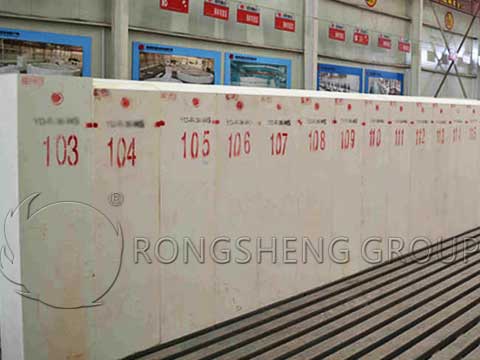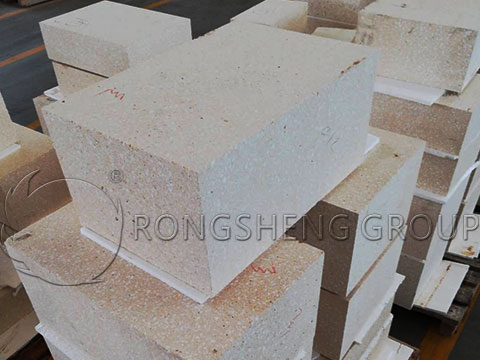What are the Refractory Bricks for the Lining of the Glass Kilns? The lining of the glass kiln is subject to chemical erosion, mechanical erosion, and large temperature fluctuations, and the refractory materials used for the glass kiln lining are like…Contact RS Refractory Company for a Free Quote. Glass is mainly made by using silica sand and soda ash as raw materials through high-temperature melting. A Glass melting furnace is thermal equipment for melting glass, usually made of refractory bricks.

Refractory Materials for Glass Furnaces
Glass melting furnaces can be divided into two categories: pool kilns and crucible kilns. According to the operation mode, it is divided into continuous operation furnaces and intermittent operation furnaces. According to the heating method, it can be divided into the flame kiln and electric heating kiln. So, how should refractory bricks be used in glass kilns? Perhaps manufacturers of refractory materials for glass kilns will answer such questions for us. Refractory Bricks Used for Glass Kiln. Because refractory bricks are widely used, from low temperature to medium temperature to high temperature, it is a necessity for the construction of the lining structure of industrial kilns.
When we choose refractory materials, we must consider many aspects. How to choose our applicable refractory brick products. First, we need to see which type of brick we need. Refractory bricks have different brick types and different uses. Secondly, we must see which kind of furnace is used and then the quality of refractory bricks. When determining the demand, the quality of the refractory bricks meets the standard and then compares the prices. Selection of refractory bricks for glass kiln is the most common type of kiln used in the glass industry. It is made of refractory bricks. There are flame-type pool kilns and electric-heated pool kilns.
The crucible kiln is to put the glass batch materials into the crucible, and then put them in the kiln to heat them together and then pour them into glass products after the materials are melted. The characteristic of this kiln is that the molten glass does not directly contact the kiln lining and the crucible is generally made of high-alumina refractory bricks and clay refractory bricks. The damage to the lining of the glass melting furnace is mainly chemical erosion and has the effect of thermal stress. The degree and speed of chemical attack are closely related to the location of use, the temperature of the furnace, and the type of molten glass. Of course, the quality of the lining itself is also very important. When choosing refractory bricks for glass melting furnaces (https://www.hy-refractory.com/service/product_knowledge/glass-tank-furnace-refractories.html), consideration should be given to the type of furnace, the location of its use, and its damage mechanism, the type of melting glass, and the type of fuel.

Fused Zirconia Corundum Bricks for Glass Kilns
Fused Zirconia Corundum Bricks. Categories Refractory Bricks. WikiTags: Lining of the Glass Kilns, Refractory Bricks. At present, fused zirconia corundum bricks and corundum bricks are widely used at home and abroad at the wall and bottom of the glass kiln in contact with the molten glass. The lower layer of the melting pool is built with clay refractory bricks. What are the precautions when using clay refractory bricks in the glass kiln? Clay refractory bricks are commonly used refractory bricks in blast furnaces, hot blast stoves, heating furnaces, ceramics, and refractory brick firing kilns. In order to achieve the best results, we need to pay attention to the following matters when used in a glass furnace.

Large Fireclay Bricks for the Glass Kilns
Large Fireclay Bricks for the Glass Kilns. 1. Clay refractory bricks cannot bear weight or be compressed when used at high temperatures. Therefore, it can only be used on the lower part of the pool wall or at a lower temperature at the bottom of the pool. 2. The gap between refractory bricks is controlled within 1.5mm~2mm. 3. The inside of the kiln shell should be flat without unevenness, let alone tilted.4. When using refractory bricks, clean the dust and slag scraps on the inner wall of the kiln shell to avoid loosening. 5. Leave a little expansion joint between the refractory bricks. 6. Bond clay refractory bricks with special cement for refractory bricks. 7. The lining of important parts and parts with complex shapes should be pre-laid first. 8. The lock seam should be firm. When processing bricks, bricks should be finely processed with a brick cutter, and manual processing of bricks should not be used. The capped bricks in the rotary kiln and under the brick slabs should not be less than 70% of the original bricks. In flat joint bricks and curved bricks, it shall not be less than 1/2 of the original bricks. It must be locked with original bricks. The processing surface of the brick should not face the inner side of the furnace. 9. Clay refractory bricks must be stored in a dry warehouse. Having mastered the selection techniques and methods of these refractory brick materials for glass kilns, I believe you will easily find the refractory bricks for glass kilns that best suit your production needs. For more information, please stay tuned to this blog.
And also the Insulating Fire Bricks Used for Kiln Linings. Insulating Fire Bricks of different materials, when used for kiln linings, can increase the heat storage function of industrial kilns and reduce the loss of energy… Contact Rongsheng for Free Quote of Refractory Bricks Categories.

